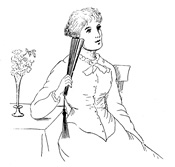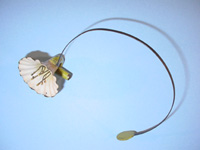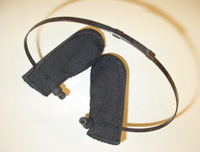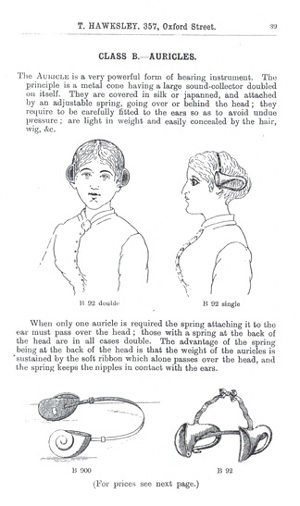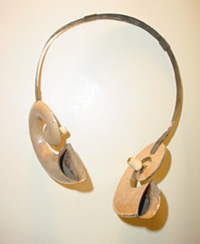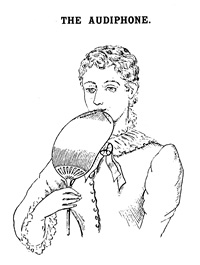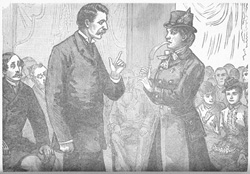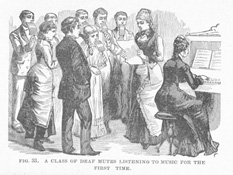Single Page View
Concealed Hearing Devices of the 19th Century
“Most hearing aids are of such size and shape that they clearly draw attention to the imperfection of the wearer. This condition is, as we have experienced, enough to make many people shrink back from using such an aid.”
— A. C. Grønbech, M.D., 1891
At the turn of the 19th century, a new trend emerged in the design of mechanical hearing devices. Clumsy and bulky devices such as ear trumpets and long speaking tubes evolved into devices that could be incorporated into everyday items or worn on the person. Public reaction or perceived reaction of others to wearing a noticeable hearing device likely influenced this trend.
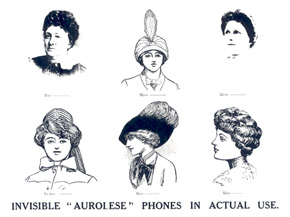 |
| Invisible Aurolese Phones |
| This F. C. Rein catalog illustration shows a variety of Aurolese Phones and the various ways in which they could be disguised or made “invisible.” |
This new trend in design toward concealment may have encouraged more users to wear hearing devices since they were cosmetically or socially acceptable for public use. It was literally a work of art to combine the elements of disguise and functionality in a form that was aesthetically appealing and yet useful for those with mild to moderate hearing loss. These mechanical hearing devices were elaborately crafted, as evidenced by repousse work, engravings, embossing, paint, and intricate grillwork. Some were enameled a flesh tint or color tinted to match one’s hair. Lace, silk, ribbons, and even feathers often adorned these devices to disguise their function. Despite such artful and ingenious attempts, soothing the vanity of the user while providing acoustic benefit was a daunting task indeed.
Acoustic Headbands are the earliest known design of a concealed hearing device. They were considered a beautiful way of camouflaging a hearing device within a hairstyle or hat. The early headbands, called Aurolese Phones, made by F. C. Rein, took various forms including simple and irregularly shaped ovoids, barrels, convoluted shells, and even fluted funnels in patterns resembling open flowers. Other headbands had two sound collectors, one for each ear.
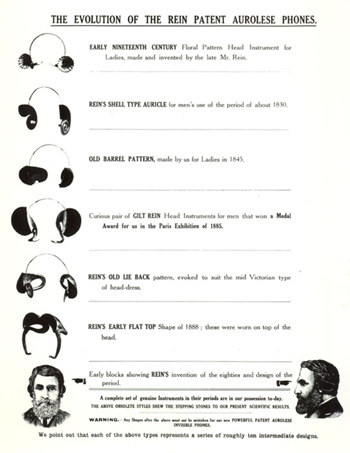 |
| The Evolution of the Rein Patent Aurolese Phones |
| This F. C. Rein catalog illustration shows the evolution of the Aurolese Phones models. |
|
| Floral Aurolese Phone |
| This floral Aurolese Phone was made by F. C. Rein about 1802. Over 200 years old, this device still shows its original white and green paint. Despite its fragile appearance and small size, the Aurolese Phone provided an acoustic benefit up to 10 dB over a limited frequency range and was appropriate for a person with a mild hearing loss. |
| View a frequency gain chart for the Aurolese Phone |
| View an Object VR movie of the Aurolese Phone |
|
|
| Barrel Headband |
| Other headband type devices include this “Barrel Pattern” headband made by F. C. Rein, England, about 1845. This headband device is covered with fabric to blend in with a hairstyle or hat. |
|
|
| Auricles from the T. Hawksley & Son catalog |
|
|
| Trumpet Headband |
| This Trumpet headband by F. C. Rein, England, was made about 1850. The metal headband could be worn either on top of the head or around the base of the neck. |
|
|
| Shell-type Auricle Headband |
| This headband by F. C. Rein was introduced around 1830 and was designed for men. Another London firm, T. Hawksley & Co., manufactured similar shell-shaped devices. |
|
|
| Hawksley Acoustic Fan |
| This catalog illustration for an acoustic fan was described as “one of the most elegant of the numerous disguised aids.” |
Acoustic Fans were very popular with women in the 19th century. Many such fans were designed to be an elegant way of concealing a hearing device within an everyday object. Several types of acoustic fans were available. Air conduction fans, often made of thin metal and shaped like a partially open fan, were held behind the ear to direct sound into the ear. In some models small trumpets were attached to air conduction fans. One of the most unusual acoustic fans was the bone conduction fan. This fan was a bizarre, yet effective device that used bone conduction to transmit sound. In bone conduction, sound is transmitted to the inner ear via the vibration of the bones in the head, such as the teeth and skull. This contrasts with the usual way that sound is transmitted to the inner ear, namely, through the air.
 |
| Air Conduction Fan |
| One common type of acoustic fan had a flat edge that allowed the user to hold the open fan behind the ear using the same principle as a discreetly cupped hand to direct the sound. Although the fan did provide some acoustic benefit, the real purpose was probably to encourage others to speak louder. |
|
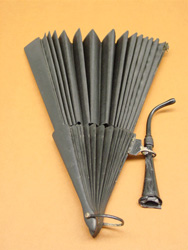 |
| Acoustic Fan with Ear Trumpet |
| Some acoustic fans had tiny ear trumpets attached and could be used either open or closed. The Hawksley Catalogue states, “Its power varies according to the size of the instrument which is attached to the fan . . . used with the fan open it gives rather better results . . .” |
|
|
Rhodes Audiphone |
| A bone conduction fan made by R. S. Rhodes is shown in this illustration. Assuming a good set of teeth, this fan provided a benefit of up to 30 dB, a gain comparable to listening to someone speaking from a distance of two feet rather than sixty-four feet. |
| See the patent drawing for the Rhodes Audiphone |
|
Dentaphone |
|
| This bone conduction fan was patented by T. W. Graydon in 1880. The Dentaphone was a round flat case with a thin diaphragm in the shape of a flat cone at the front center of the case. The user held the case in his hand and a small wooden piece in his mouth was gripped tightly by the teeth. Sound was picked up by the diaphragm, and was passed to the user’s teeth via vibrations through a piece of silk-covered wire. |
|
|
|
| Audiphone Fan |
| The Audiphone was advertised as enabling “thousands . . . to attend concerts and theatres . . . Music is heard perfectly with it when without it not a sound could be distinguished.” |
“Such graceful forms, not detracting from efficiency,
these artful forms hid one’s deficiency.”
Continued
1 | 2 | 3 | 4 | Next >>


